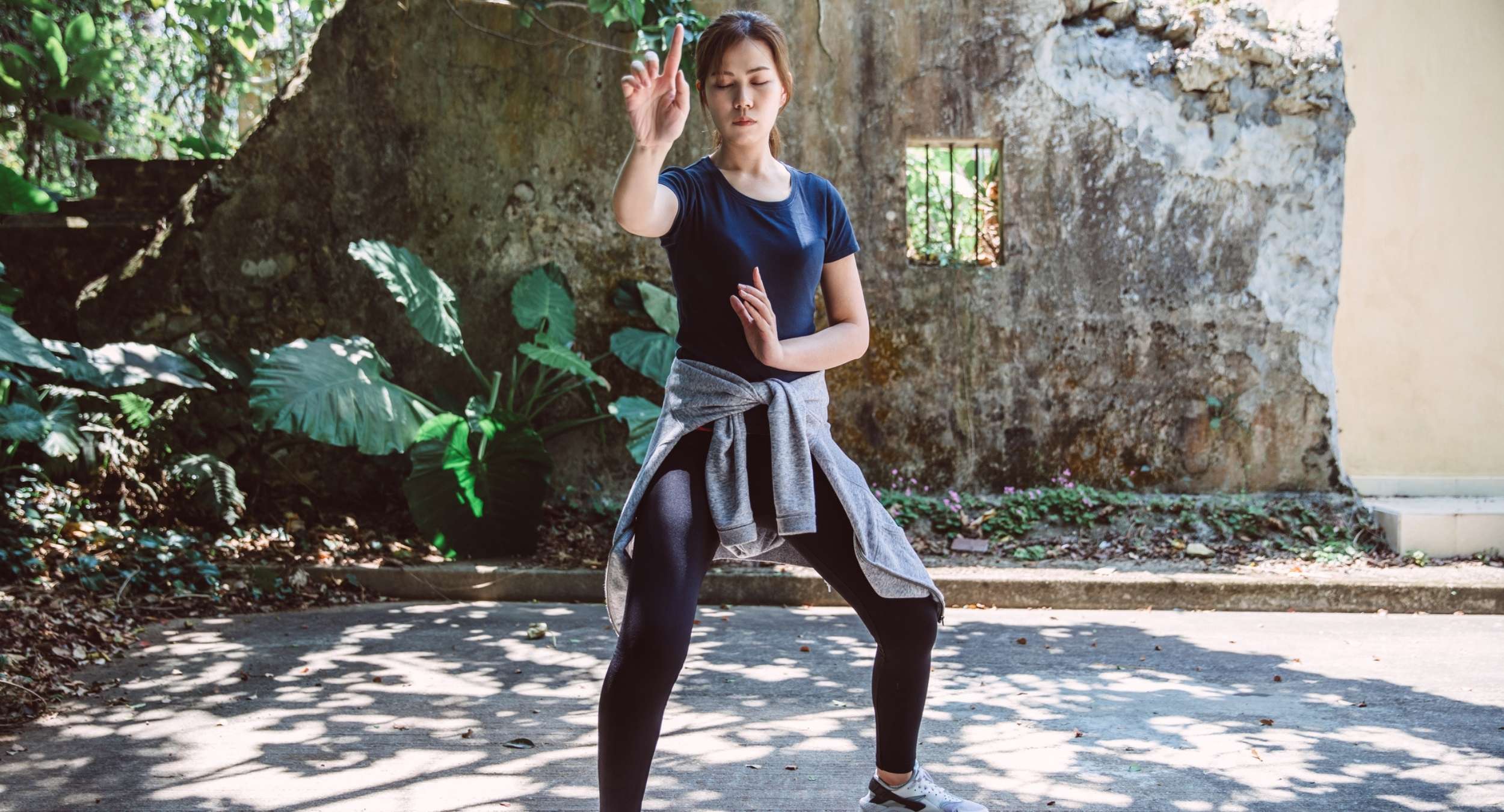5 Reasons to Add Tai Chi to Your Exercise Routine

(Photo: GettyImages)
Adding physical activity to your day isn’t all about being drenched in sweat while lifting heavy weights or running intervals on the treadmill. In fact, meeting the Center for Disease Control and Prevention’s recommendation of doing muscle-strengthening activities two or more days per week doesn’t require dumbbells at all.
Let us introduce tai chi (pronounced TIE-CHEE), a gentle but effective practice that can help strengthen and stretch muscles while improving balance. To learn more, we brought in experts George Yang, ISSA- and IFPA-certified fitness trainer and the founder and chief designer at Yanre Fitness, as well as Jenelle Kim, DACM, expert martial artist and author of Myung Sung: The Korean Art of Living Meditation (Watkins Publishing, 2022).
Trust us when we say, you’ll be wondering why you didn’t add tai chi to your exercise routine earlier.
What Is Tai Chi?
Tai chi is an ancient Chinese tradition often referred to as “meditation in motion.” The movements are slow and focused, with each posture continuously flowing into the next. There are many different styles, but they all remain low impact while incorporating deep breathing, focus and relaxation.
The five different types of tai chi are called Chen, Yang, Hao, Wu and Sun. While they are all unique, they also have the same purpose. “My master has always said, ‘All true tai chi masters look the same when they fight.’ It’s like climbing a mountain,” Yang says. “[The styles] might start on opposite sides of the mountain, but when they get to the pinnacle of tai chi, they’re all at the same place.”
For instance, Kim enjoys her daily routine of qigong (CHEE-gung). Instead of multiple movements flowing into each other, qigong focuses on one movement being repeated. She mentions in doing this that you may find “longevity, ultimate health inside and out, and your way of connecting to the earth and nature around you.”
5 Reasons to Add Tai Chi to Your Exercise Routine
For both Kim and Yang, tai chi is just a natural part of their daily routine. Kim states that it is an “amazing practice for anyone at any age” and that it can “bring both physical and mental benefits.”
The following are some of the science-backed benefits you may notice once you add tai chi to your exercise routine:
- Improves anxiety and sleep. A study published in Nature and Science of Sleep found that 10 weeks of tai chi intervention on 75 adults (aged 18 to 40) showed decreased levels of anxiety over time and improved sleep quality scores.
- Lessens stress. Thanks to the slow and controlled movements of tai chi, you may see improvements with tension, mental concentration and breathing control, according to the Journal of Clinical Medicine. In studies, participants who added tai chi to their exercise routine five times per week for 60 minutes had a significant reduction in stress.
- Supports immune system. When our immune system is working to fight against certain infections, injuries or toxins, it triggers an inflammatory response. While this process is normal, it can become chronic, meaning it lingers for far too long. Chronic inflammation may lead to health issues such as heart disease and diabetes. One systematic review and meta-analysis published in Medicines found that practicing tai chi and qigong could assist with our immune functioning and inflammatory responses.
- Improves cognition and brain health. Our cognitive health influences our ability to think, learn and remember. These abilities can start to decline gradually as we age. According to a study published in BMC Geriatrics, participants with mild cognitive impairment had significant improvement in general cognitive functions when practicing tai chi compared to the groups that were not.
- Cements a mind-body connection. Everyone wants to feel that elusive mind-body connection, but most people don’t know where to find it. According to a 2017 study, tai chi and qigong are excellent exercises to implement in order to keep this connection balanced. “What’s honestly more important than being aware of your own body and mind?” Kim says. “One of the reasons I personally love tai chi, if we can put our minds into our body, it’s amazing what we can feel. I love the awareness that it brings.”
While it’s not guaranteed you will receive all these benefits once you start practicing tai chi, the research is promising. Plus, tai chi is a generally safe exercise that won’t come with unpleasant side effects, as long as the moves are done properly.
How to Get Started
If you’re ready to add tai chi to your exercise routine, do so in a way that works best for you. “Make it convenient for yourself,” Kim suggests. “Pick a time every day to try to incorporate it or a few times per week until it’s a habit.”
While you can easily search for videos of different tai chi moves to do from home, it may be best for beginners to scope out a local gym or studio that offers tai chi to ensure the moves are being done correctly. If that’s an option for you, Kim recommends finding a place that is connected to a “master” or a very good teacher.
Whether you’re at home or the gym, avoid wearing anything too restrictive while you’re going through the tai chi motions. “You don’t ever want to cut off flow, so loose clothing is typical attire,” Kim says.
When it’s all said and done, you just have to start without any set rules. “It’s an exercise anybody can do, no matter what kind of shape they’re in, and has all the benefits associated with regular exercise,” Yang concludes.